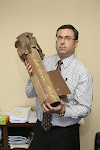Almost immediately, their battalion commander was wounded, and Cahaner was thrust into the leadership. As the men crept forward and casualties mounted, he concentrated on the task at hand: advancing toward the museum. But he wasn’t only focused on the present.
“I knew in my head that this was something historic,” Cahaner recalled on Friday, 45 years later. Even in the midst of the heavy fighting, he said, “I knew it was a very important event, and a really important war for the Jewish people.”
On Sunday, as the nation celebrates Jerusalem Day and the anniversary of the reunification of the capital during the Six Day War, the 77-year-old Cahaner, who now lives in Kibbutz Neveh Eitan near Beit She’an, will join dozens of his fellow soldiers along the same road that they fought so hard to capture 45 years ago. At points where they fought with Jordanian forces, the veterans will lay wreaths and honor their fallen comrades.
Cahaner said that even today he gets chills when he drives though east Jerusalem or sees the city from afar, knowing he played a part in its history.
“Every day, I feel the honor that I had to be responsible for Jerusalem,” he said.
“Jerusalem is not the same as any other place.”
Fifteen years ago, on the 30th anniversary of the war, Cahaner took part in a mission that united Israeli commanders who fought in Jerusalem with their Jordanian counterparts.
“It was a really emotional meeting,” Cahaner remembered.
“We were ready to kill each other 30 years ago... But the Jordanians told us, ‘We fought like lions. But you, you fought like people who are ready to give your lives for Jerusalem. Every time we saw people who were wounded, we thought we had stopped you. But it was impossible to stop you.’” That’s the message that Cahaner wants to make sure the younger generation doesn’t forget.
“If we don’t educate about our right to Jerusalem, we could lose Jerusalem,” he said. Without our history, he added, we are nothing.
Veterans from the Six Day War drove that point home symbolically on February 20 of this year, when they removed the giant Israeli flag that flies over Ammunition Hill and locked the doors to protest the government’s lack of funding for the site that memorialized the Battle of Ammunition Hill of June 6, 1967. As they marched with the flag to the Prime Minister’s Residence, Binyamin Netanyahu convened an emergency meeting and, at the last minute, promised a yearly budget of NIS 2 million.
Ammunition Hill, which hosts 150,000 visitors and dozens of army ceremonies each year, reopened the next day, but only after a public outcry forced the government to act.
But Cahaner believes that the government understands the importance of the site, pointing to the fact that Netanyahu will hold the weekly cabinet meeting at Ammunition Hill on Sunday.
Cahaner was the director of Ammunition Hill for 18 years and, after retiring, has been a volunteer for the past decade.
Last year on Jerusalem Day, the annual Dance of Flags march degenerated into violence.
Thousands of participants thronged through the east Jerusalem neighborhood of Sheikh Jarrah, chanting “Death to Arabs” while some threw rocks and got into physical altercations. This year, in an effort to reduce tensions, the parade was moved back to the route through west Jerusalem.
What is it like for someone so caught up in this history to watch the celebration deteriorate into violence and arrests? Cahaner is fiercely proud of his role in the capital’s history, but he acknowledged that there are times when the Jerusalem of today is not the Jerusalem he envisioned as he fought in the trenches.
“Today there are clouds over the city – violence and struggle between religious and secular,” he said. Extremism is the biggest threat that the city faces, he said, both haredi extremism and Muslim extremism.
“We need to be realistic and give an opportunity to others, including Arabs, to live and enjoy the importance of this city on a world stage,” he said. “If we can attain peace, this could be the most important city in the world.”

